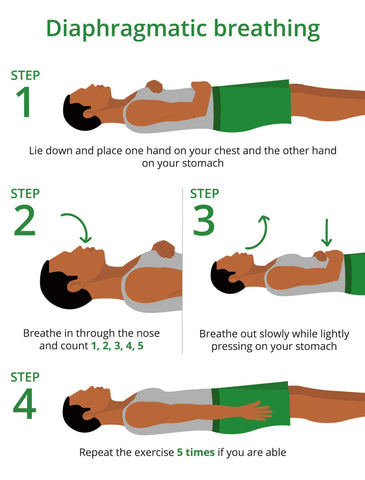In today's fast-paced world, stress and anxiety have become all too common. However, one natural, cost-effective method to manage these challenges is breathing training. This technique, when practiced regularly, can significantly reduce stress, calm the mind, and improve overall well-being. In this article, we explore the science behind breathing training, its benefits for mental health, and actionable steps to incorporate it into your daily routine.
Understanding Breathing Training
Breathing training is a structured practice that involves controlled breathing exercises designed to activate the body’s relaxation response. By focusing on your breath, you can slow down your heart rate, lower blood pressure, and reduce the production of stress hormones. These physiological changes help counteract the symptoms of anxiety and stress, leading to a calmer state of mind.

Modern research has increasingly supported breathing training as an effective tool for mental and physical health. Studies show that controlled breathing techniques can improve emotional regulation, enhance concentration, and even boost overall lung capacity. Whether you're dealing with the pressures of work or personal life, incorporating breathing training into your routine can provide a natural way to regain balance.
The Science Behind Breathing Training
The human body is naturally equipped with mechanisms to handle stress, but chronic anxiety can overwhelm these systems. Breathing training works by stimulating the parasympathetic nervous system—the part of your body responsible for rest and relaxation. Deep, slow breaths increase oxygen flow to the brain and help reduce the "fight or flight" response that is often triggered by anxiety. This balance is essential for maintaining mental clarity and emotional stability.

Furthermore, breathing training helps to create a mindfulness state where you can be fully present. This mindfulness aspect allows individuals to observe their thoughts and emotions without judgment, reducing the impact of negative feelings and promoting a more positive outlook.
Benefits of Breathing Training for Anxiety and Stress Relief

-
Reduced Anxiety Levels: Regular practice of breathing training helps lower anxiety by calming the nervous system and reducing stress hormone levels.
-
Improved Focus and Concentration: As the mind becomes less cluttered with anxious thoughts, you can experience improved focus and cognitive clarity.
-
Enhanced Emotional Regulation: With consistent breathing training, individuals often report better control over their emotional responses, leading to a more balanced mood.
-
Lower Blood Pressure and Heart Rate: Physiological benefits of controlled breathing include improved cardiovascular function, which can further mitigate the physical symptoms of stress.
-
Improved Sleep Quality: Many people who practice breathing training report a significant improvement in sleep quality, as the calming effects of deep breathing help to unwind the body before bedtime.
How to Start Breathing Training
For those new to breathing training, here are some simple steps to get started:

1. Find a Quiet Space
Choose a calm, quiet environment where you won’t be disturbed. This will help you focus solely on your breathing and allow your mind to settle.
2. Practice Diaphragmatic Breathing

Diaphragmatic breathing, a core component of breathing training, involves breathing deeply into your diaphragm rather than your chest. Sit or lie down comfortably, place one hand on your stomach, and inhale slowly through your nose so that your hand rises. Exhale slowly through your mouth, letting your hand fall. Repeat this process for several minutes.
3. Use Guided Breathing Exercises
Many apps and online resources offer guided breathing training sessions. These tools can provide structured exercises and help track your progress, making it easier to integrate the practice into your daily routine.
Related article: The Role of Breathing Exercises and How Oxygenvip Can Help You Manage COPD
4. Establish a Regular Routine
Consistency is key to reaping the benefits of breathing training. Aim to practice at least once or twice a day, gradually increasing the duration as you become more comfortable with the techniques.
5. Combine with Mindfulness Meditation
Incorporating mindfulness meditation with breathing training can further enhance its benefits. As you breathe, focus on the sensations of the air entering and leaving your body, allowing yourself to remain fully present in the moment.
Integrating Breathing Training into Your Daily Life
The effectiveness of breathing training lies in its simplicity and adaptability. It can be practiced virtually anywhere—in the office during a short break, at home before sleep, or even during a stressful commute. Over time, this practice can become a cornerstone of your self-care routine, providing a reliable tool to manage anxiety and stress.
Businesses like Oxygenvip recognize the importance of holistic wellness. By promoting techniques such as breathing training, they not only support respiratory health but also enhance overall quality of life. Integrating breathing training into your daily routine is a proactive step towards managing stress and cultivating a calmer, more focused mindset.
Conclusion
Incorporating breathing training into your lifestyle is a powerful strategy to combat anxiety and stress. By understanding the science behind controlled breathing and its numerous benefits—from reduced anxiety levels to improved sleep quality—you can make informed decisions about your mental health. Start with simple diaphragmatic exercises, use guided sessions, and be consistent in your practice. Over time, you'll notice a significant improvement in your ability to manage stress, contributing to a healthier, more balanced life.
For further information on breathing training techniques and holistic wellness products, consider exploring offerings from Oxygenvip. Their commitment to respiratory and overall well-being ensures you receive high-quality resources to support your journey toward better health. Embrace breathing training as a tool for both relaxation and empowerment, and take the first step towards a calmer, more resilient future.















